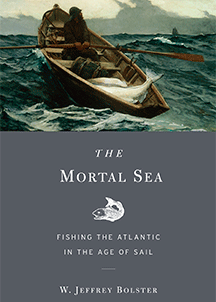By David L. Kirchman
As another mark of our time’s hubris, we congratulate ourselves for thinking that, while we may be denuding the environment, at least we know it, and some of us are trying to stop it. This book shows how wrong that view is. W. Jeffrey Bolster tells the history of fish and fisheries in the North Atlantic Ocean and of complex relationships between nature and society when fishing vessels were powered by oar or sail. By the time we read late in this wonderful book that “overfishing” was coined in the mid-1800s, the only surprise is that it took so long for the term to come about.
Bolster, a marine environmental historian, argues that early reports of huge, abundant fish in New World waters were not all hyperbole, pointing as proof to the number and consistency of the stories and to contemporaneous paintings of fishermen and their catch. The size and number of fish in North American waters were in contrast to the depauperate fisheries left behind by early European explorers. Europeans went to fish the sea only after freshwater fisheries had declined, and by the late Middle Ages, salted herring was the hamburger of today, to use Bolster’s analogy. As early as 1289, however, King Philip IV of France complained about the “evils of fishers.” On the other side of the Atlantic, by 1639 the first fishery regulation was enacted in New England to outlaw the use of cod for fertilizer. We share Bolster’s amazement that fishermen armed only with primitive gear in dories, powered by oar or small sail, could have such an impact. The first U.S. federal regulation did not come about until 1887, only after menhaden, mackerel, and halibut stocks had crashed.
The signs of overfishing were familiar to fisherman, even if the term was not, long before the 19th century. As early as the mid-1700s Newfoundlanders had to venture further offshore as inshore fishing grounds became depleted. Fish became smaller as well as scarcer. The phrase, “fishing down the food chain,” invented to describe the impact of today’s industrial fisheries, accurately captures the change in the fisherman’s prey in the age of sail. Fishermen went after forage fish like mackerel and herring after larger, predatory fish like cod and tuna were gone.
The switch in fish targeted by fishermen was also effected by changes in taste and technology. Since the Basque first made bakaiļao, cod was favored in part because it preserves well in salt while other species, such as haddock and flounder, became popular only when they could be preserved with ice, which was first carried to sea in 1845. Bolster tells us that lobsters, previously fed to hogs and servants, became a viable fishery only after finfish stocks collapsed and appropriate preservation methods developed. This revolution in preservation methods coincided with the development of railroads that transported “freshly-frozen” fish to inland markets from fishing centers in New England.
Technology also changed the lives and fishing practices of fisherman. Steam engines, first used on fishing boats in the late 19th century, powered bigger nets and safer, longer fishing trips. But long before then, simpler, often more profound changes had occurred. Single hooks at the end of a couple lines were replaced by long-lining in which each fisherman used hundreds of hooks tethered to a long groundline. Even more potent and destructive than hooks were the improved nets and nets with new designs such as tub-trawls, purse seines and point nets. Their use led to the coining of another term, by-catch, to describe the catching of unwanted fish along with the desired fish. By-catch were and still are thrown back into the sea, usually dead or soon to be.
Bolster has written a serious book, complete with an appendix, glossary, and detailed notes of his sources. Although not light, his writing is enlivened by colorful nautical phrases and vivid descriptions of fishing and fishermen and of landlubber politicians and know-it all scientists. The book ends with the plea of a historian: that today’s assessment of fish stocks should be placed in context of the past. An optimistic report of a fishery today may be less rosy when stacked up against historical numbers. But too many reports are already grim even without the historical perspective. I wonder if Bolster eats fish.
David L. Kirchman (ΦBK, Lawrence University, 1976) is the Maxwell P. and Mildred H. Harrington Professor Marine Biosciences at the University of Delaware and a resident member of the Alpha of Delaware chapter of Phi Beta Kappa.




